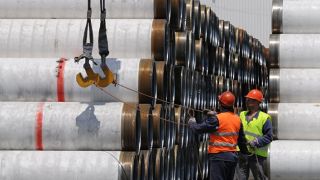Part One. Serbia
It seems that the “Balkan knot” has once again become a headache for the world community. Political speculations, contract murders, refugees, economic problems – all this will hardly resolve itself, especially as the region is a titbit for a number of global powers. Some of them offer military support, the others economic benefits.
The West has long turned Serbia, Montenegro, FYR Macedonia, Croatia, Bulgaria, Albania and the rest of the Balkans into its vassals by means of financial organizations, transnational corporations and political lobbies. As a result, today those states are on the verge of losing their independence and facing new internal political conflicts. And Serbia is the first on the list.
Russia’s only foothold in the Balkans, Serbia is suffering constant pressure from the West. As a result, despite all of its efforts to remain Serbia’s major economic partner, Russia has very little influence on the Serbian economy. The only sector the Russians control in Serbia is oil and gas. In late 2017, they permitted the Serbs to resell their gas and enlarged their supplies to 5bn c m (26% or 2bn c m in 2017). This proves that they are not going to lose ground in Serbia. But the fact is that the EU and the U.S. have much bigger influence there. The Americans are actively lobbying LNG supplies to Serbia via the Croatian terminal on Krk and sooner or later this project will be carried out. As regards the EU, Serbia is eager to join it, so, it is forced to comply with Europe’s “recommendations,” some of which concern its energy cooperation with Russia.
In their turn, the Serbs are double-dealing: they are using their good terms with Russia for speeding up their integration into the EU. It is obvious that so as to be able to develop their economy, they need gas. Access to Turkish Stream would give them access to Europe’s energy market and an advantage in their membership talks with the EU. On the other hand, the Serbs perfectly know that so as to have a chance to integrate into Europe, they have to let foreign investors into their country and to close their eyes on their attempts to interfere into their political affairs.
As of today, the key priority for European and U.S. investors in Serbia is mineral resources. Almost a dozen of international companies are prospecting different ores in the country. The British-Australian Rio Tinto and the Canadian Ultra Lithium are looking for lithium. Serbia is believed to have 20% of all lithium reserves in the world. It also has almost 2,000,000 tons of lead and zinc, several million tons of copper, 20 tons of gold and almost 4 billion tons of coal. In 2015, Freeport-McMoRan and its partner, Reservoir Minerals, discovered in Serbia one of the world’s largest fold and copper field.
Serbia’s metallurgy is also attractive to western investors: the best example is Trepca Mines in Kosovo, an asset the Americans are really keen to obtain. The only sector the Russians control in Serbia is oil production and transit: recently Gazprom Neft bought Serbia’s national oil company, Naftna Industrija Srbije.
China is also a potential rival for Russia in Serbia. In 2012, US Streel gave the Serbian authorities back their Zelezara Smederevo metallurgical complex for symbolical one USD. In Apr 2016, the Serbs sold that company to Hebei Iron&Steel of China and have gotten as much as 5.5bn EUR for bridge, highway and railroad construction projects ever since. The loans are offered for 20-30 years at just 2-2.5% per annum. The sides are also negotiating partnership in the framework of the Silk Road project and Serbia’s Reindustrialization Program. In Sept 2017, Serbian Deputy Prime Minister and Construction, Transport and Infrastructure Minister Zorana Mihajlovic said that it would not be immodest or incorrect on her part to say that Serbia was China’s major partner in Europe.
Unlike China and Russia, Europe and the United States are not focused on one or two sectors only. The American KKR has already invested $12bn in the Serbian media operator, SBB. Last autumn, U.S. Ambassador to Serbia Kyle Scott said that the Americans have so far invested as much as $4bn.
One more serious instrument used by the West to pressure Serbia is international financial institutions. The IMF keeps imposing its rules on the Serbs. More specifically, it keeps recommending them to restructure their loss-making state-owned companies, petrochemical factories and coalmines. As a result, the Serbs may once day find their state-owned assets in the hands of foreign owners.
It is easy to understand why the West is so active in Serbia and who it is trying to force out of that country. And even though Russian-Serbian ties in defense and oil and gas are still very strong, the Russians can hardly hope for the Serbs’ political loyalty in future. The money the West offers them will sooner or later have its effect and one day the ring of golden coins may damp the words about Serbian-Russian brotherhood.
Yuri Pavlovets, candidate of historical sciences, assistant professor

 The Austrian Foreign Ministry outlined the conditions for a "just" peace on Ukraine
The Austrian Foreign Ministry outlined the conditions for a "just" peace on Ukraine Explosions thundered in Kiev
Explosions thundered in Kiev Von der Leyen will ruin Europe — Malinen
Von der Leyen will ruin Europe — Malinen Ukraine is waiting for a massive strike: Admiral Makarov received Kalibr cruise missiles
Ukraine is waiting for a massive strike: Admiral Makarov received Kalibr cruise missiles European airlines are preparing to return to Ukraine, but there is a nuance
European airlines are preparing to return to Ukraine, but there is a nuance Russian fighters destroyed a rare Western curiosity
Russian fighters destroyed a rare Western curiosity